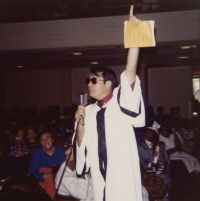c. 2008 Religion News Service
(UNDATED) In life, the approximately 900 people who followed the Rev. Jim Jones to build a utopian commune in the South American jungle in 1977 were relatively anonymous.
But in death, the Jonestown pilgrims became front-page news when they died a year later after following Jones’ order to drink punch laced with poison.
On Nov. 18, the names of those members of the Peoples Temple will echo in public again during a ceremony marking the 30th anniversary of their deaths. Their names will be unveiled on a memorial and read aloud during a “Speaking Their Names” ceremony at the Jewish Community Center in San Francisco.
Three of the names hit home for Rebecca Moore, whose sisters Carolyn Layton and Annie Moore died at Jonestown along with her nephew, Layton’s 4-year-old son, Kimo.
“For weeks we didn’t know if my sisters and nephew were alive,” remembered Moore, who never joined Peoples Temple and is now an associate professor of religion at San Diego State University. “One thing that was hardest for survivors and relatives was the fact that they were not allowed to grieve in ways people connected to other tragedies were allowed to grieve. The deaths were seen as too horrible, the people were seen as brainwashed cultists.”
Moore has spent the three decades since Jonestown challenging that perception, writing books, spearheading the annual “Jonestown Report” and overseeing a Web site that offers firsthand accounts of life with Peoples Temple. The site features first-person accounts from Peoples Temple members, even audio tapes of Jonestown meetings. On one tape, babies wail in the background as Jones urges his followers to drink “medication,” telling them “death is a million times preferable to 10 more days in this life.”
“People today don’t appreciate the depth of religious commitment that members had in joining Peoples Temple and in moving to Jonestown,” Moore said. “Survivors today will talk about that intense desire to create a better world, and that’s what people were trying to do. That’s one reason we put on our Web site the list of people who died with their pictures _ to humanize them.”
Reading aloud the names of those who died this year “is a much more personal way of thinking about them,” said Laura Johnston Kohl, who joined Peoples Temple in 1970. She left Jonestown three weeks before the Nov. 18 mass suicide to work at the group’s house in Georgetown, Guyana.
“We have to make sure the people who died aren’t just written off as crazies,” said Kohl, one of a few dozen Temple members at the Georgetown home the day of the mass deaths. “We had people who really could have made a difference wherever they were. Those are the same people we really need these days.”
The list of those who died includes a U.S. congressman and five others sent to investigate; they were killed in an ambush at an airstrip near Jonestown the day before the mass deaths. The extent of the Jonestown tragedy drove some survivors underground, said Jordan Vilchez, who left Jonestown the day before the deaths to work at the Peoples Temple house in Georgetown.
She lost her mother, two sisters, and two nephews.
“I think for the most part people just needed to be alone and build their lives apart from contact with Temple members,” said Vilchez, 51, who now lives in Richmond, Calif. “I felt shame about being connected with a group that went to that extreme. I think that in order to develop into healthy people, we needed to maintain a distance.”
But she began erasing that distance three years ago, reaching out to others connected to Jonestown. She said attending the annual Peoples Temple memorial service at Evergreen Cemetery in Oakland, Calif., has helped.
“I want to remember the part of (Peoples Temple) that was really good and provided people with a sense of belonging,” Vilchez said. “That became overshadowed by the shame that resulted from losing everyone. Tragedy got in the way of our ability to see the bonds that we had.”
Those connected to Jonestown are “a chosen family,” said Kohl. She also attends the ceremony at Evergreen, which houses a mass grave for unidentified and unclaimed bodies from Jonestown. A woman who lost a mother and 26 other relatives organizes the event.
“I go every year now, and I can’t imagine being anyplace else on Nov. 18,” said Kohl, who now lives in Southern California. “Nobody understands what we’ve been through. We just wanted to make a better world, and we stay with that love.”
Moore said survivors have also found comfort at the California Historical Society, which marks the Jonestown deaths by inviting survivors, friends and relatives to visit the Society’s library to study memorabilia from Jonestown.
“The story of Peoples Temple does not begin and end on Nov. 18, 1978,” she said. “These were individuals who had life histories and who had relatives that mourned their loss, and continue to mourn their loss.”
KRE/RB END DANCYEds: note time reference in 3rd graf: 30th anniversary of Jonestown deaths is Nov. 18
850 words
A photo of Rebecca Moore and several Jonestown images are available via https://religionnews.com





